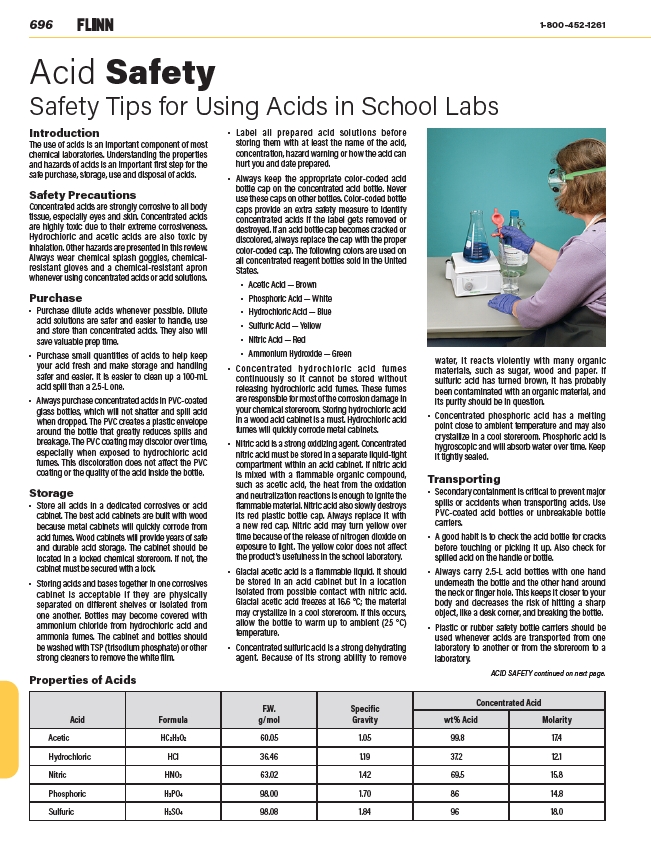
696 1-800-452-1261
Acid Safety
Safety Tips for Using Acids in School Labs
• Label all prepared acid solutions before
storing them with at least the name of the acid,
concentration, hazard warning or how the acid can
hurt you and date prepared.
• Always keep the appropriate color-coded acid
bottle cap on the concentrated acid bottle. Never
use these caps on other bottles. Color-coded bottle
caps provide an extra safety measure to identify
concentrated acids if the label gets removed or
destroyed. If an acid bottle cap becomes cracked or
discolored, always replace the cap with the proper
color-coded cap. The following colors are used on
all concentrated reagent bottles sold in the United
States.
• Acetic Acid — Brown
• Phosphoric Acid — White
• Hydrochloric Acid — Blue
• Sulfuric Acid — Yellow
• Nitric Acid — Red
• Ammonium Hydroxide — Green
• Concentrated hydrochloric acid fumes
continuously so it cannot be stored without
releasing hydrochloric acid fumes. These fumes
are responsible for most of the corrosion damage in
your chemical storeroom. Storing hydrochloric acid
in a wood acid cabinet is a must. Hydro chloric acid
fumes will quickly corrode metal cabinets.
• Nitric acid is a strong oxidizing agent. Concentrated
nitric acid must be stored in a separate liquid-tight
compartment within an acid cabinet. If nitric acid
is mixed with a flammable organic compound,
such as acetic acid, the heat from the oxidation
and neutralization reactions is enough to ignite the
flammable material. Nitric acid also slowly destroys
its red plastic bottle cap. Always replace it with
a new red cap. Nitric acid may turn yellow over
time because of the release of nitrogen dioxide on
exposure to light. The yellow color does not affect
the product’s usefulness in the school laboratory.
• Glacial acetic acid is a flammable liquid. It should
be stored in an acid cabinet but in a location
isolated from possible contact with nitric acid.
Glacial acetic acid freezes at 16.6 °C; the material
may crystallize in a cool storeroom. If this occurs,
allow the bottle to warm up to ambient (25 °C)
temperature.
• Concentrated sulfuric acid is a strong dehydrating
agent. Because of its strong ability to remove
Introduction
The use of acids is an important component of most
chemical laboratories. Understanding the properties
and hazards of acids is an important first step for the
safe purchase, storage, use and disposal of acids.
Safety Precautions
Concentrated acids are strongly corrosive to all body
tissue, especially eyes and skin. Concentrated acids
are highly toxic due to their extreme corrosiveness.
Hydrochloric and acetic acids are also toxic by
inhalation. Other hazards are presented in this review.
Always wear chemical splash goggles, chemicalresistant
gloves and a chemical-resistant apron
whenever using con centrated acids or acid solutions.
Purchase
• Purchase dilute acids whenever possible. Dilute
acid solutions are safer and easier to handle, use
and store than concentrated acids. They also will
save valuable prep time.
• Purchase small quantities of acids to help keep
your acid fresh and make storage and handling
safer and easier. It is easier to clean up a 100-mL
acid spill than a 2.5-L one.
• Always purchase concentrated acids in PVC-coated
glass bottles, which will not shatter and spill acid
when dropped. The PVC creates a plastic envelope
around the bottle that greatly reduces spills and
breakage. The PVC coating may discolor over time,
especially when exposed to hydrochloric acid
fumes. This discoloration does not affect the PVC
coating or the quality of the acid inside the bottle.
Storage
• Store all acids in a dedicated corrosives or acid
cabinet. The best acid cabinets are built with wood
because metal cabinets will quickly corrode from
acid fumes. Wood cabinets will provide years of safe
and durable acid storage. The cabinet should be
located in a locked chemical storeroom. If not, the
cabinet must be secured with a lock.
• Storing acids and bases together in one corrosives
cabinet is acceptable if they are physically
separated on different shelves or isolated from
one another. Bottles may become covered with
ammonium chloride from hydrochloric acid and
ammonia fumes. The cabinet and bottles should
be washed with TSP (trisodium phosphate) or other
strong cleaners to remove the white film.
water, it reacts violently with many organic
materials, such as sugar, wood and paper. If
sul furic acid has turned brown, it has probably
been contaminated with an organic material, and
its purity should be in question.
• Concentrated phosphoric acid has a melting
point close to ambient temperature and may also
crystallize in a cool storeroom. Phosphoric acid is
hygroscopic and will absorb water over time. Keep
it tightly sealed.
Transporting
• Secondary containment is critical to prevent major
spills or accidents when transporting acids. Use
PVC-coated acid bottles or unbreakable bottle
carriers.
• A good habit is to check the acid bottle for cracks
before touching or picking it up. Also check for
spilled acid on the handle or bottle.
• Always carry 2.5-L acid bottles with one hand
underneath the bottle and the other hand around
the neck or finger hole. This keeps it closer to your
body and decreases the risk of hitting a sharp
object, like a desk corner, and breaking the bottle.
• Plastic or rubber safety bottle carriers should be
used whenever acids are transported from one
laboratory to another or from the storeroom to a
laboratory.
ACID SAFETY continued on next page. Properties of Acids
Acid Formula
F.W.
g/mol
Specific
Gravity
Concentrated Acid
wt% Acid Molarity
Acetic HC2H3O2 60.05 1.05 99.8 17.4
Hydrochloric HCl 36.46 1.19 37.2 12.1
Nitric HNO3 63.02 1.42 69.5 15.8
Phosphoric H3PO4 98.00 1.70 86 14.8
Sulfuric H2SO4 98.08 1.84 96 18.0